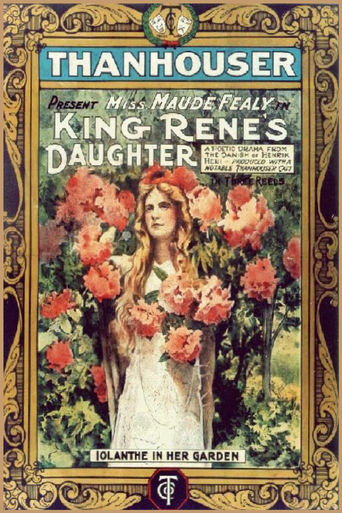deickemeyer
A three-reel number, introducing Maude Fealey to the moving picture audiences of the country. She won an international beauty contest a number of years ago, and her grace and girlish beauty, reinforced by years of training on the legitimate stage, make a strong appeal in the films. The entire Thanhouser Company enter into the spirit of this story of the beautiful blind princess, who must not be informed of her blindness until she is sixteen. Then the count discovers her and breaks the spell and she recovers her sight. A whimsical story, full of beauty and charm. The close could have been handled with more strength, but it is a very good production as it stands. - The Moving Picture World, July 12, 1913
Cineanalyst
"King René's Daughter" has the typical faults of early longer films (this one is three reels and near 40 minutes, which was feature-length for then). The same camera positions, which are mostly straightforward, static long shots, are returned to for scenes in the same location, with barely any scene dissection. There's some panning to keep actors within frame and slight crosscutting when required, but that's quite basic. It gives the film a very stagy look. The set for the opening crowd scene is especially lacking; it's a very narrow passage, filled with actors and props, which serve in part to block the absence of a complete set—claustrophobic blocking, as fellow commenter boblipton remarked. Thankfully, most of the production takes place outside in a garden, which gives it a freer appearance, so that it doesn't look entirely like a filmed play. The acting is also typically dated and theatrical, although not nearly as bad as in some other early films. I think Maude Fealy plays blind comparatively well.This film could have done a couple interesting things, but doesn't. Like many early screen adaptations, it seems mostly concerned with rendering the plot. There's the common story of an arranged marriage where one ends up falling in love with the one he thought he didn't want to marry. The filmmakers could have equated blindness with knowledge, with the secluded garden being an allegory for the Garden of Eden. Even better, they could have used the character's blindness to illustrate the visual nature of the art of cinema. Yevgeni Bauer did this, to an extent, in "For Luck" (Za schastem) (1917). A better example, although made a couple decades later than this, is Chaplin's "City Lights" (1931).
boblipton
This elaborate and well-staged silent version of Hertz' play is exceedingly well produced for 1913: it starts off by introducing the actors by name and role, then showing them in double exposure in street clothes and in costumes. The production values are also elaborate and the look of the set designs reminds one of the elaborate backdrops that Melies used in his shots.However, it also shows the problems that afflicted Thanhouser: the shots are long, static, and all too often, tightly, almost claustrophobically blocked. The acting is stage acting, and even though care is taken with crowd compositions, the effect is occasionally jarring.Still, the elaborate sets and costumes, as well as the fun of the story moves things right along. Very worthwhile for anyone interested in the evolution of the American movie in this critical period.



